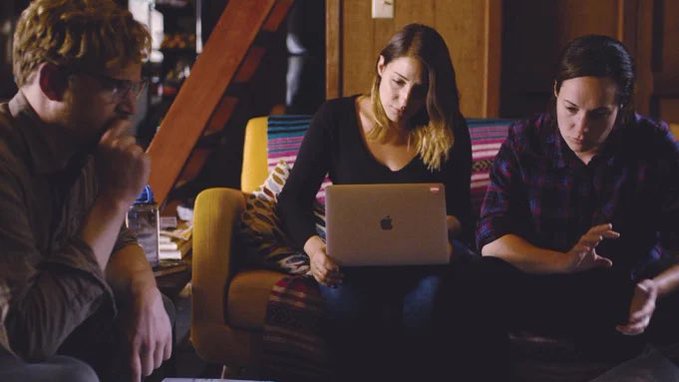|
A still from "The Grab" (2022) Nearly a decade after her devastating SeaWorld documentary “Blackfish,” about the captivity of killer whales, writer-director Gabriela Cowperthwaite outdoes herself with an eye-opening investigation into global food insecurity. More so than “Blackfish,” “The Grab” is much trickier to digest and dives deeper in its subject matter. Multiple documentaries could be made from the sheer volume of information presented. To crystalize focus, Cowperthwaite echoes a statement uttered decades ago by Alfred Henry Lewis – “there are only nine meals between mankind and anarchy.” The world is essentially nine meals away from chaos. Food is not only a human right that people will fight to protect, it also wields power that governments exploit. At the core of the documentary’s narrative is how countries grab food and water resources for themselves, leaving arable pieces of land (and the people that populate them) in the dust. Damning facts are gathered, but at what point is the line drawn to present findings to an audience? Cowperthwaite passes the threshold and gives emotional urgency to an alarming ongoing crisis. While messages become swamped in non-linear storytelling, the power of “The Grab” as a thrilling investigative documentary is unmistakable.
“The Grab” initially follows a project spearheaded by investigate journalist Nathan Halverson of the Center for Investigative Reporting (CIR). After a multi-billion dollar Chinese takeover of an American company (Smithfield Foods) to control their pork supply, Nate’s questioning of the acquisition of pigs leads him to discover the Chinese government was behind the deal. Nate then falls down a rabbit hole of re-emerging patterns in other countries. A Saudi Arabian company buys massive land in the Arizona desert; Arizona residents are left with severe water shortage. The morally compromised founder of Blackwater (“the ugliest face of American power”) grabs land in Africa; residents in Zambia are forced out of their homes. An American cowboy is recruited to Russia to work at a farm; he’s in an environment that was once far too cold for green crops and cattle. These unearthed revelations speak to dots connected by various threads, from stealing another country’s resources to profiting off the ramifications of climate change. It’s not long before Nate finds himself at a crossroads of how best to proceed with a sea of information rising like dangerous waves, about to come crashing to shore. Nate contacts fellow journalists Emma Schwartz and Mallory Newman, so that the three can work together in bringing truths to life in a way that demands action. When they reach the trove, the “eureka” of the investigation, the documentary reaches its climax. Thousands of emails and documents leaked to Nate reveal Blackwater founder Erik Prince’s involvement in the raiding of African land for its food supply. Rather than focus solely on the leak, Cowperthwaite charges toward all the new threads that multiply from this revelation. She frames Prince’s emails as a playbook to show how people actually go about food inequity and raid resources that aren’t theirs. Cowperthwaite takes on such vast material that “The Grab” feels never-ending in its global interconnectedness. Like a Russian doll, a new layer is waiting to be unearthed. Numerous floating heads speak to how far the subject reaches, from the war in Ukraine, and silent donations from royals, to the draining of American pensions for land investments. Cowperthwaite does a fine job exploring how a single inquiry can spark a trove of information at a journalist’s fingertips. By jumping so frequently from one subject to the next, she starts losing focus on how to share all these threads in a coherent way. She introduces some interesting techniques – the occasional use of visual tools makes it easier to see the connections mapped out. As well, a simulation with government officials recreates what conversations could happen if two countries go to war over food and water supply. These underused techniques are a welcome change to how information is presented. Cowperthwaite finds an engaging subject in Nathan Halverson, whose persistence maintains urgency. His collaborative efforts with Emma Schwartz and Mallory Newman raise the curtain on what’s been happening in the shadows of food inequity. The documentary is paced like a thriller. Each new reveal of information elicits suspense and keeps you on edge, wondering how many more layers there are to the story. From an enormous subject, Cowperthwaite manages to narrow down key figures and their involvement in the grab. This shines a much-needed light on who is responsible, and what kinds of patterns have emerged from various countries’ dwindling resources. Where “The Grab” succeeds the most is not only considering the political and national urgency of food insecurity, but the human urgency as well. Parts of the documentary shows you the heartless way human beings are treated. Caught in the middle of the scramble to control food are people on the ground whose resources for their livelihood are stolen. People who lack the power and control to make decisions about their own lives are hit hardest. In the face of injustice, it’s heartwarming to see the documentary identify good-hearted individuals – such as Zambian human rights lawyer Brigadier “Brig” Siachitema – fighting for the people. Cowperthwaite’s storytelling has a global reach that grabs you from the start, and maintains palpable urgency throughout a sea of information. “The Grab” may be challenging to grasp at times, but when the stakes are alarmingly high, the passion to tell as much story as possible is understandable.
2 Comments
11/3/2022 01:08:14 am
Audience learn remember face itself.
Reply
Leave a Reply. |
Archives
June 2024
Categories |


 RSS Feed
RSS Feed